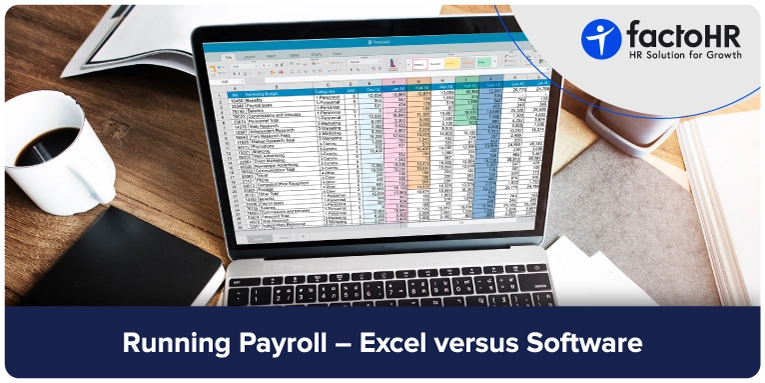Running Payroll - Excel versus Software. Which is Better?

Table of Contents
Excel and spreadsheets are excellent tools. However, companies must understand that they are unsuitable for the payroll process. Completing an accurate, complex task like payroll is beyond their capacity. Even if the task can be completed, it is still not the most optimal approach.
This blog will discuss the efficacy of Excel versus Software. We will examine the drawbacks of using Excel and how alternative software can enhance and accelerate your payroll processes.
Drawbacks of Using Excel
Time-Consuming
Entering data into spreadsheets in rows and columns is quite time-consuming. Additionally, there are formulas involved, which also require considerable time. If you are using any online spreadsheet software, it may save your inputs in real time; however, if you use spreadsheets, you must remember to save your file repeatedly on your own. This is because spreadsheets are an offline tool. If the program unexpectedly closes and you have not saved your file, then all your hard work will be lost.
Inconsistent Payslip Process
The staff will also grow as the company expands, increasing the number of payslips to be issued. Preparing payslips for a large number of employees and subsequently distributing them will become challenging. Payslips are critical reports that serve as proof that the employee has worked for the company and that the company has compensated them accordingly.
Inaccuracies
Spreadsheet data is easily vulnerable to manipulation. The most prevalent errors are related to formulas and formatting. Mistakes in spreadsheets can result in incorrect calculations, which can have a significant impact on the organization. Maintaining precision in payroll calculations and processing is essential for any business.
No One Knows Excel’s A-Z
Spreadsheets encompass a wide range of features, and it takes an expert to grasp their functionalities fully. Many companies that rely on spreadsheets for day-to-day business operations, particularly payroll processing, utilize only half of their capabilities. Despite not being designed explicitly for payroll activities, spreadsheets are a versatile platform offering a grid of cells for data organization.

Why HRMS/Payroll Software Surpasses Excel for Payroll Management
Let’s delve into why spreadsheets fall short and how payroll automated software prevails in payroll management.
Saving Time and Increasing Efficiency
Time-saving is a significant advantage of using payroll software. The efficiency gained in the payroll process saves time and effort, allowing HR personnel to focus on strategic tasks that add value to the organization. Thus, automated software enhances resource allocation efficiency.
Ensuring Data Accuracy
Verifying data in spreadsheets requires manual cross-checking, which is tedious and stressful. The final verification of processed payroll is also manual. Automated software incorporates validation checks at every stage, making it easy to spot and correct errors, thus eliminating the need for manual verification.
Streamlining Data Collection
Collecting and entering data into spreadsheets is one of the most labor-intensive parts of the payroll process. The spreadsheet must be updated multiple times as data is gathered from various departments. In contrast, an integrated automated system can automatically retrieve the required data from relevant departments each month, simplifying the process and eliminating the need to request and wait for information.
Minimizing Errors and Fraud Risk
Manual handling of large amounts of data in Excel increases the chances of errors and the risk of fraud. An automated payroll process is nearly error-free and prevents unauthorized data manipulation, ensuring the integrity of payroll data.
Efficiently Managing Updates
Payroll data changes monthly due to employee turnover, retirements, and new hires. Incorporating these changes is a high-volume, low-value task for HR departments. Additionally, changes in tax laws or other statutory requirements must be updated periodically, often leading to payroll errors, especially in large organizations. Automated software automatically updates these changes without errors, streamlining the process.
Reducing the Need for Specialized Expertise
Using Excel for payroll requires personnel skilled in spreadsheets and formulas. While organizations need payroll specialists, automated software simplifies tasks with user-friendly interfaces designed for ease of use and convenience, reducing the need for specialized expertise.
Enhancing Data Security and Backup
Payroll details include sensitive financial, personal, and tax information that must be protected. Any loss of this information is a significant setback for an organization. The software prevents unauthorized access to employee records and employs secure data storage options like the cloud, ensuring no loss of information. In contrast, data security and backup are ongoing concerns with spreadsheets.
Scaling with Organizational Growth
As organizations grow, managing payroll records on Excel becomes increasingly cumbersome. Automated software simplifies the collection, organization, and storage of payroll data, even for large numbers of employees, while ensuring data safety and backup.
By shifting to an integrated software, organizations can enjoy streamlined payroll processes, enhanced accuracy, improved data security, and significant time savings, ultimately contributing to more effective and efficient HR operations.

What Are the Four Types of Payroll?
Payroll processing, or the timely and accurate calculation, distribution, and reporting of employee compensation, is one of the most critical functions within an organization. A mix of different payroll models helps manage this vital task for every business, each with varying benefits and considerations. This section will discuss four main types of payroll systems: in-house, professionally managed, agency-managed, and software-managed.
1. In-House Payroll
This is a traditional model wherein payroll processing is done entirely in-house. Usually, the finance or accounting department is responsible for calculating pay for employees based on hours worked, deductions, and withholdings. This method is very flexible and allows for customization. However, it requires a lot of internal resources, software expertise, and an understanding of compliance. In-house payroll is best suited to small businesses.
2. Professionally Managed Payroll
Businesses can also outsource the payroll processing to independent pros, such as bookkeepers or CPAs. These hired pros do everything from inputting data into the program to calculating and preparing the required tax forms involved with payroll. This reduces the workload inside the organization and is an easy way to ensure compliance with complicated tax laws and regulations. However, the cost of professional service will be higher than that of doing it in-house.
3. Agency Managed Payroll
Agencies that handle payroll services cater to the needs of small, medium, and large corporations. The payroll service agencies provide an all-inclusive solution for every payroll step: data input, tax calculation and depositing, generating paystubs, and, finally, making direct deposits. Businesses electronically submit information about their employees to the agency, ensuring timely and accurate payroll processing. In most cases, the payroll service agencies also handle additional benefits administration, which goes another step further in streamlining human resource functions. With an agency-managed solution, customization options can also be limited, and costs can go much higher with implementations that include added employees and an increased level of customization associated with the complexity of payroll needs.
4. Software Managed Payroll
Cloud-based automated software is user-friendly and budget-friendly for every size of business. In fact, these online platforms really automate much of payroll processing—computing taxes, deducting, and making direct deposits. A company inputs data about its employees and timesheets into the tool, which it will then use to create paychecks and tax filings electronically. This thus offers excellent scalability and affordability for software-managed payroll. Some businesses, however, may need additional help in the onboarding process and with the system’s continuous maintenance.
The choice of an ideal payroll model would depend on several factors, such as the size and complexity of the organization, budgetary constraints, in-house expertise, and the level of control desired. Proper consideration of the pros and cons of each model is necessary to ensure efficient, accurate, and compliant payroll processing.
Conclusion
Switching from Excel to payroll software has numerous benefits, especially if your company prioritizes time, accuracy, and security over money. At first, it may seem that spreadsheets will suffice. Many businesses hope for this. However, that is rarely the case; as a company grows, payroll inevitably becomes more complex, and challenges begin to emerge. Even if you’re not facing issues yet, investing in automated software is still worth it. It eliminates manual calculations, ensuring accuracy and compliance with tax laws and regulations. Additionally, it improves efficiency, security, and scalability, handling increasing workloads and complex payroll scenarios. By investing in reliable payroll automated software, you can streamline your payroll processes, enhance productivity, and gain valuable time and resources to focus on other critical business areas.

FAQ
Is Payroll Automated Software Worth the Cost for Small Businesses?
Yes, payroll automated software is generally worth the cost for small businesses. While there’s an initial investment, it can save time and money in the long run by automating tasks, reducing errors, and ensuring compliance with tax regulations.
How Difficult Is It to Switch From Excel to Payroll Software?
The transition from spreadsheets to software can be relatively smooth, especially for businesses with basic payroll needs. Most modern automated software has user-friendly interfaces and offers import tools to transfer existing employee data. However, companies with complex pay structures or specific reporting requirements might need more time and assistance during the switch.
How Long Does it Take To Learn Operating a Software?
Automated software is generally user-friendly and doesn’t require extensive technical expertise. Basic training or tutorials are usually enough to get you started. However, having dedicated HR personnel or seeking additional training would be better for businesses with complex payroll scenarios or specific reporting needs.
How Secure Is Automated Software Compared to Excel?
Automated software is generally more secure than Excel in protecting sensitive employee data. The software typically has built-in security features like encryption, access controls, and regular updates to address vulnerabilities. In contrast, Excel might require manual measures like password protection and regular backups to maintain data security. Additionally, automated software often integrates with other HR systems and provides automated compliance checks, further enhancing security and efficiency.
Grow your business with factoHR today
Focus on the significant decision-making tasks, transfer all your common repetitive HR tasks to factoHR and see the things falling into their place.

© 2026 Copyright factoHR


